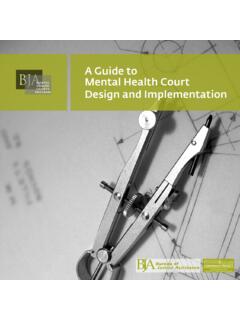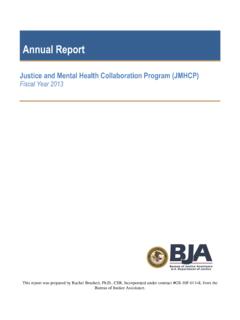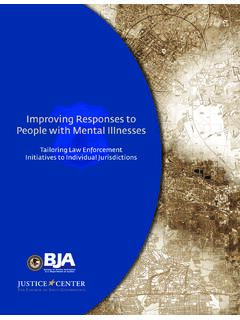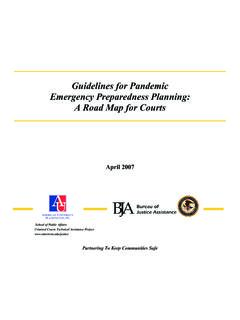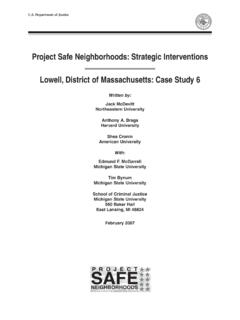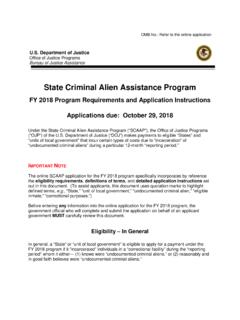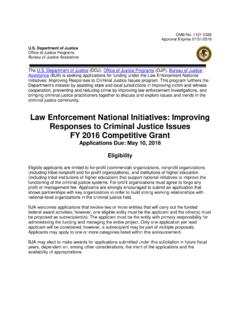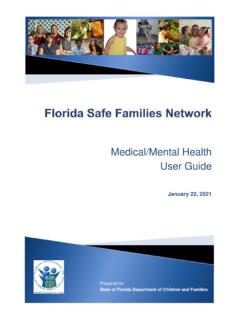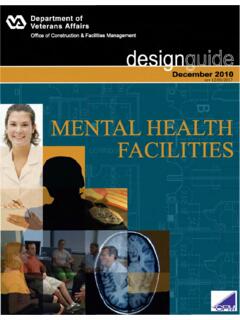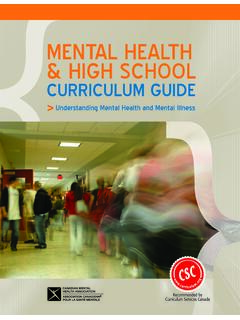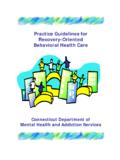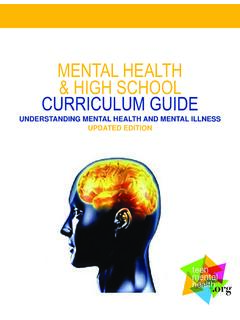Transcription of Mental Health Courts - Bureau of Justice Assistance
1 Mental Health Courts :A guide TO RESEARCH-INFORMED POLICY AND PRACTICEL auren AlmquistElizabeth DoddCouncil of State Governments Justice CenterNew York, New YorkSupported project was supported by Grant No. 05-82376-000-HCD, awarded by the John D. and Catherine T. MacArthur Foundation. Points of view or opinions in this document are those of the authors and do not necessarily represent the official position or policies of the MacArthur Foundation, members of the Council of State Governments, or the project s advisory group. The Council of State Governments Justice Center is a national nonprofit organization that serves policymakers at the local, state, and federal levels from all branches of government.
2 The Justice Center provides practical, nonpartisan advice and consensus-driven strategies, informed by available evidence, to increase public safety and strengthen of State Governments Justice Center, New York 10005 2009 by the Council of State Governments Justice CenterAll rights reserved. Published 2009. Cover design by Mina Bellomy and interior design by David Summary ..vAcknowledgments ..viiIntroduction ..1 SECTION ONE: Mental Health court design and Function ..5 SECTION TWO: Mental Health court Outcomes ..21 SECTION THREE: Future Research Questions and Implications for Policy and Practice ..27 Conclusion ..29 Appendix A: Essential Elements of a Mental Health court ..31 Appendix B: Areas for Further Research/Outstanding Research Questions.
3 33 Notes ..37 Bibliography ..41 Executive SummaryvOverviewIn recent years, the large number of individuals with Mental illnesses involved in the criminal Justice system has become a pressing policy issue within both the criminal Justice and Mental Health systems. The prevalence of serious Mental illnesses among all people entering jails, for example, is estimated to be percent ( percent of men and 31 percent of women).1 People with Mental illnesses often cycle repeatedly through courtrooms, jails, and prisons that are ill-equipped to address their needs and, in particular, to provide adequate treatment. Over the past decade or so, policymakers and practitioners have been exploring new ways of responding to these individuals to break this costly and damaging cycle and to otherwise improve outcomes for the systems and individuals involved.
4 One of the most popular responses to emerge has been the Mental Health court , which combines court supervision with commu-nity-based treatment services, usually in lieu of a jail or prison sentence. Mental Health Courts generally share the following goals: to improve public safety by reducing criminal recidivism; to improve the quality of life of people with Mental illnesses and increase their participation in effective treatment; and to reduce court - and corrections-related costs through administrative efficiencies and often by providing an alternative to incarceration. This guide is intended to assist policymakers and practitioners in assessing the utility of Mental Health Courts . After briefly describing who participates in Mental Health Courts and how these Courts function, this guide reviews research findings that address the extent to which Mental Health Courts have been found to achieve their stated goals.
5 Because Mental Health Courts are relatively new, many unanswered questions remain on how they work, for whom, and under what circumstances; these outstanding research questions are highlighted in the final portion of this guide . MethodologyTo develop this guide , the authors conducted an extensive literature review, worked closely with research-ers and court practitioners from across the country to identify common questions about Mental Health Courts , and distilled answers from the available research. The authors then convened an advisory group of leading researchers and practitioners that met in October 2008. The advisory group reviewed summaries of research findings and provided input on which studies to include in the guide , how to interpret their findings, and what policy statements could be derived from the relevant research.
6 ConclusionsThe body of research on Mental Health Courts is quite limited at this stage, both in terms of the number of studies and their scope. The studies conducted to date have measured and reported different out-comes, partly because Mental Health Courts vary in terms of who participates and how the Courts operate. Executive SummaryMental Health Courts : A guide to Research-Informed Policy and PracticeviDespite these limitations, the authors and the advisory group were able to reach consensus on a number of conclusions, including ..the design and function of Mental Health In general, Mental Health Courts are increasingly likely to accept individuals charged with more serious offenses including felonies and, in some jurisdictions, violent crimes.
7 Most Mental Health court participants have serious Mental illnesses, and many also have co-occurring substance use disorders. Mental Health court team members usually include a judge, representatives from the defense bar and the district attorney s office, probation/parole officers, and case managers and/or representatives from the Mental Health system. Referrals to a Mental Health court program most commonly come from defense attorneys, judges, jail staff, or family members. Mental Health Courts employ incentives and sanctions tailored to the circumstances and needs of each participant to motivate him or her to engage in treatment and comply with the terms of participation..and what research suggests about Mental Health court Participants in some Mental Health Courts have lower rates of recidivism and, in particular, are less likely to be arrested for new crimes than individuals with Mental illnesses who go through the traditional criminal court system.
8 Some empirical evidence shows this trend continues after graduation when individuals are no longer under court supervision. Mental Health Courts are more effective than the traditional court system and jails at connecting participants with Mental Health treatment services. Over time, Mental Health Courts have the potential to save money through reduced recidivism and the associated jail and court costs that are avoided, and also through decreased use of the most expensive treatment options, such as inpatient short, existing research supports the idea that Mental Health Courts may produce positive outcomes for their participants and for the public; however, much more data are needed to bolster confidence in these conclusions.
9 Furthermore, for policymakers and practitioners to be able to design the most effective Courts , they need empirical evidence about which aspects of Mental Health Courts have the greatest positive effects, why, and for these questions will help to strengthen the Mental Health court model by identifying appropriate target populations and revealing key practices. In addition, further research may pinpoint elements of Mental Health Courts that traditional Courts could implement to possibly improve outcomes for people with Mental illnesses across the criminal Justice system. With these goals in mind, this guide identifies key areas for future research that could augment the encouraging findings to date. AcknowledgmentsviiThis publication was made possible through the leadership and support of the John D.
10 And Catherine T. MacArthur Founda-tion. In particular, the Council of State Governments Justice Center would like to thank Steven Casey, Grants and Budgets Manager at the MacArthur Foundation. The authors are also indebted to advisory board member Dr. Jen-nifer Teller, Project Director of the Department of Community Health Sciences at Northeastern Ohio Universities and Dr. Fred Osher, Direc-tor of Health Systems and Services Policy at the Council of State Governments Justice Center. Drs. Teller and Osher were instrumental in shap-ing the scope and direction of this publication and provided in-depth consultation on the docu-ment in draft form. The Justice Center also thanks the members of this publication s advisory group, listed below, who reviewed drafts of the document and met in October 2008 to discuss their reactions to an early version of the publication.
